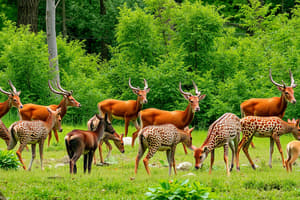Podcast
Questions and Answers
What type of factors increase their impact as the population size increases?
What type of factors increase their impact as the population size increases?
- Density dependent factors (correct)
- Resource availability
- Carrying capacity limits
- Environmental conditions
Which phase of population growth is characterized by rapid increase without significant limiting factors?
Which phase of population growth is characterized by rapid increase without significant limiting factors?
- Deceleration phase
- Sigmoid phase
- Exponential phase (correct)
- Plateau phase
Which of the following best describes the relationship between breeding and deaths in a population approaching carrying capacity?
Which of the following best describes the relationship between breeding and deaths in a population approaching carrying capacity?
- Decreased breeding and decreased deaths
- Increased breeding and decreased deaths
- Decreased breeding and increased deaths (correct)
- Increased breeding and deaths remain constant
What can be inferred about the results of using models like mesocosms in studying population dynamics?
What can be inferred about the results of using models like mesocosms in studying population dynamics?
Which of the following describes a scenario that leads to exponential population growth?
Which of the following describes a scenario that leads to exponential population growth?
What is the definition of a population in an ecological context?
What is the definition of a population in an ecological context?
Which method is best suited for estimating the population size of sessile organisms?
Which method is best suited for estimating the population size of sessile organisms?
Which statement about carrying capacity is correct?
Which statement about carrying capacity is correct?
In the context of estimating population size using capture-mark-release-recapture, what does 'R' represent?
In the context of estimating population size using capture-mark-release-recapture, what does 'R' represent?
What is a primary characteristic of density-dependent factors affecting population size?
What is a primary characteristic of density-dependent factors affecting population size?
Which method utilizes random sampling to estimate the size of a population?
Which method utilizes random sampling to estimate the size of a population?
Which of the following assumptions must be made during the capture-mark-release-recapture technique?
Which of the following assumptions must be made during the capture-mark-release-recapture technique?
What does 'sampling error' refer to in the estimation of population size?
What does 'sampling error' refer to in the estimation of population size?
Study Notes
Populations and Communities Overview
- A population consists of individuals of the same species that interact and live in a defined area.
- A species is characterized by its ability to interbreed and produce fertile offspring.
Estimation of Population Size
- Population size is estimated rather than directly counted, particularly useful for large populations.
- Sampling involves selecting a random sample, where each member has an equal chance of being chosen.
- Quadrat sampling involves a fixed-size frame for estimating the size of sessile organisms.
- Sampling error represents the discrepancy between actual and estimated values.
Quadrant Sampling for Sessile Organisms
- Quadrat method is effective for counting non-moving organisms.
- Random sampling is achieved through marking boundaries and using random numbers for selection.
- Standard deviation can be used to measure variability in the data collected.
Capture-Mark-Release-Recapture Method
- Used for estimating population size of motile organisms.
- Process includes capturing, marking, releasing, and later recapturing individuals.
- The Lincoln index formula calculates population size: ( \text{Population size} = \frac{M \times N}{R} ), where:
- M = initially marked individuals
- N = total individuals captured in the second round
- R = number of recaptured marked individuals
- Assumptions include no migration, no births or deaths during the study, and marks being visible without affecting survival.
Carrying Capacity and Competition
- Carrying capacity refers to the maximum population size that an ecosystem can sustain.
- Each habitat has unique carrying capacities based on available resources.
- Competition arises from limited resources such as water, food, light, and territory.
Density-Dependent and Density-Independent Factors
- Negative feedback controls population size, leading to periodic population fluctuations that stabilize over time.
- Density-independent factors affect populations regardless of their density, e.g., natural disasters like fires.
- Density-dependent factors only impact larger populations significantly:
- Increased competition, predation, and spread of diseases or parasites can lead to greater mortality and reduced reproduction.
Population Growth Curves
- Sigmoid curves illustrate population growth dynamics with distinct phases:
- Exponential growth occurs in the absence of effective density-dependent factors or in resource-rich environments.
- Carrying capacity showcases the plateau phase when resources become limited.
Modeling Sigmoid Population Growth Curves
- Models can be created using small environments (mesocosms) with plentiful resources to observe growth.
- Experiments may utilize organisms like duckweed or yeast, focusing on how initial population numbers and resources influence carrying capacity.
- Examination of model strengths and limitations is essential to understand real-world applications.
Studying That Suits You
Use AI to generate personalized quizzes and flashcards to suit your learning preferences.
Related Documents
Description
Explore the key concepts related to populations and communities in IB Biology HL. This quiz covers definitions, interactions among species, and methods of estimating population size through random sampling. Test your knowledge and understanding of how populations function within ecosystems.




